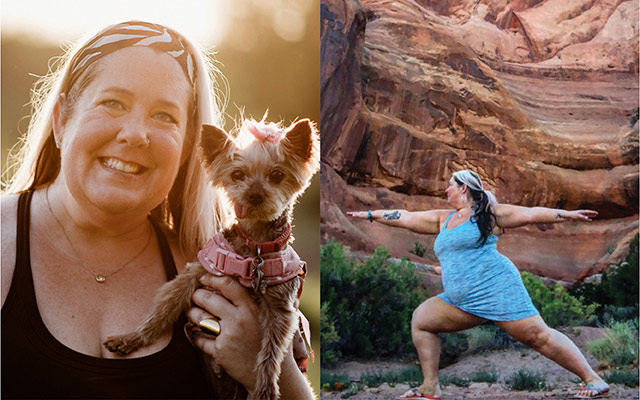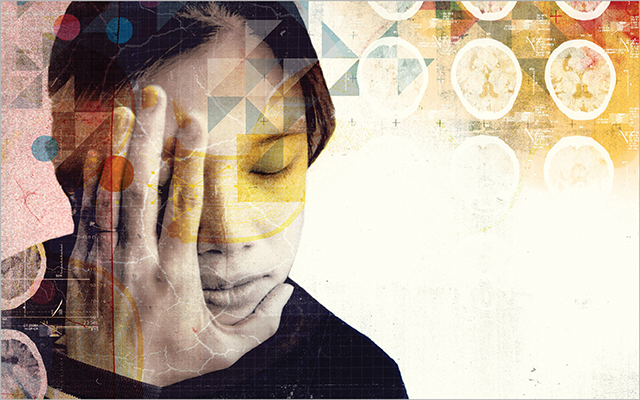One cold winter day in February 2014 I went out for a walk. It changed my life forever.
Even now, six years later, I still remember the sound of my head hitting the frozen concrete as I slipped on my icy driveway in St. Paul, Minn. I had been carrying my little Yorkie dog, Pixxie. When I came to, Pixxie was far down the drive, staring back at me with what seemed like a worried look. I may have been knocked out for a minute or two.
As soon as I stood up, I realized I wasn’t OK. I was dizzy, wobbly, sick to my stomach. There were little lightning bolts in the corners of my eyes — the proverbial seeing stars. And I ached, from my head through my shoulders and down my back.
I realized I needed to go to the ER. I was new to town, so I tried to locate the nearest hospital on my computer, but I couldn’t read the screen.
That’s when I sensed I had a real problem.
Broken
I telephoned a neighbor for help. She put a package of frozen peas on my head and then asked the old question, “Who’s the president?” I answered, “Bill Clinton.” I was two presidents off.
A friend’s husband was a chiropractic neurologist and immediately made time to see me at his office. He told me I had a concussion as well as whiplash from the jolt, including torn muscles, maybe some bruised ribs, and a dislocated sternum.
I went in to see him a couple of times each week over the next month. I think he adjusted me and patched me up — I don’t really remember.
The stars disappeared after a few days, but I still had dizzy spells. I felt like I had been on a boat or had just taken off roller skates and I was still moving. It was like I was drunk all the time. Other days, I felt like I had a bad head cold and was lost in a fog.
And I had aphasia and short-term memory lapses. I struggled to concentrate and got tired easily. Strange mood swings disrupted my days.
My MRI showed no issues — which is often the case with a traumatic brain injury, or TBI. My neurologist reassured me, “Just give it time.”
But time didn’t cure me. I worked as a writer and photographer but couldn’t operate my computer or camera. I transposed numbers, dates, my finances. I couldn’t remember words or appointments. I wrote emails in my head but never sent them — and never realized it.
Over the next two years, I saw multiple specialists. Nothing helped. I was finally referred to a craniosacral therapist, who worked on realigning my skull. After a few treatments, I remember hearing a noise in my head and feeling a huge sense of relief. That sound signaled a release of pressure, which instantly cleared my fogginess.
But the cognitive issues continued. I went in for a four-hour neuropsychological exam — and scored worse than a dementia patient. A psychologist prescribed Ritalin and antidepressants. I refused to take them: I didn’t know what the real problem was, but I suspected these medications would treat only my symptoms.
I knew that I was really broken.
The Invisible Disability
When you get injured, you can choose to be pissed off and a victim or you can choose to be pissed off and a fighter. I saw myself as a victim at first, especially when I wasn’t getting any answers from doctors. But I made the decision to do what I could to make the most of it.
I submitted a blog about my experience to the Huffington Post on the one-year anniversary of my fall and it went crazy, stupid viral. I got thousands of emails, messages, and tweets from other people who were suffering with brain injuries.
I discovered that TBIs are an invisible disability. Your brain is jarred when you get a concussion, but you don’t actually have to hit your head. TBIs can occur from whiplash, or even from the shock waves of an explosion, as troops experience in combat.
TBIs are also quite common: Every nine seconds someone in the United States sustains one. Experts estimate that 5.3 million Americans are currently living with a lifelong affliction — that’s about one of every 60 people around you.
Fortunately, in August 2016, someone else read my story: Jeremy Schmoe, DACNB, a chiropractic functional neurology diplomate who runs the Functional Neurology Center in Minnetonka, Minn. He contacted me and — for the first time in all my consultations — validated all my many symptoms. I was like, Hallelujah, somebody understands!
He examined my balance and how I walked, and checked my eye–brain coordination. He discovered my eyes weren’t tracking together, a condition called nystagmus. One eye was lagging behind, perhaps causing my dizziness — which can activate your fight-or-flight response, permanently.
Dr. Schmoe showed me some simple exercises to help me restore my eye–brain coordination. My dizziness quickly went from 10 to a two. I think my body had been focused on trying to keep me from falling over; without the dizziness, I had space in my brain to start healing.
He also had to teach me how to walk all over again. My gait was impaired from the TBI and I hadn’t realized it: I was shuffling, not fully lifting my feet, and I wasn’t moving my arms as I walked.
He recommended several functional strategies for recovery. He advised me to exercise. I went for walks — maybe just a couple of minutes in the beginning, then longer stretches. I soon realized this was energizing.
He also recommended yoga, such as TBI survivor Kevin Pearce’s LoveYourBrain program. I had always done yoga but now I couldn’t figure out how to do the poses. This was partly due to my neck and chest injuries, but I also simply couldn’t remember postures.
My instructor helped me find five poses I could do — seated poses, cat–cow, and so on. With yoga, I could feel my range of motion and strength improving.
I began taking turmeric and vitamin D for their anti-inflammatory qualities; B vitamins; omega-3 fatty acids; probiotics; and magnesium, which may help with muscle cramping and easing headaches. I also eat lots of eggs — the choline in them is key to cognitive health — and I crave them on days when my brain feels fuzzy. I simply can’t eat enough over-easy eggs.
Sleep is also key. The first six months after my fall, I slept 14 to 15 hours a night, plus took a three-hour nap. But after that, I couldn’t sleep at all — which becomes a vicious cycle, because your brain heals while sleeping.
About a year ago, I started taking CBD oil and slept like a baby the first night. I’ve been taking it ever since.
Multitasking
It’s been six years since my fall, and I’m still not 100 percent — I can’t go to work all day, I still have fatigue and headaches. But I finally feel like a contributing member of society again. Just recently, I was working at my computer and suddenly realized I was multitasking!
A TBI is not like having a cut that you can see heal; you have to notice these little things. So I continue to do my exercises and functional-neurology therapy.
I’ve also started new work: raising TBI awareness. I started a Facebook page (Amy’s TBI Tribe), began podcasting (Faces of TBI), and have a YouTube channel (AmyZellmerTBI). I lobby at state and national legislatures, and I’m serving on the advisory council of the Brain Injury Association of America.
I self-published two books about my story, then collected survivor stories into an anthology. With Kickstarter backing, I’ve just launched both a print and digital version of The Brain Health Magazine.
And I hope to soon resume traveling the country to photograph TBI survivors for my #NOTINVISIBLE campaign. My goal is to someday organize an exhibit and publish a photo book.
I’m also working as a patient advocate with Dr. Schmoe and conducting a TBI research survey with the advocacy organization CTE Hope and Simpson College in Iowa.
Spreading the word about recovery from TBI is now my full-time job. It’s become my purpose in life, and I feel very fortunate.
Amy’s Top 3 Success Strategies
1. Know that there is help out there. “Most general practitioners and even neurologists don’t know much about brain injuries,” Amy says. “Seek out alternative healthcare providers, such as functional neurologists and cognitive vision therapists.”
2. Act. Now. “Don’t take ‘I don’t know’ or ‘Give it time’ for an answer. The sooner you get treatment, the better — time is of the essence,” she says. “Still, no matter how long ago your brain injury occurred, there’s always hope for improvement.”
3. Continue to have hope. “Don’t compare your recovery with anyone else’s. Just as no two brain injuries are alike, neither are any two recoveries.”
This originally appeared as “Conquering Concussion” in the July-August 2020 print issue of Experience Life.




This Post Has 0 Comments